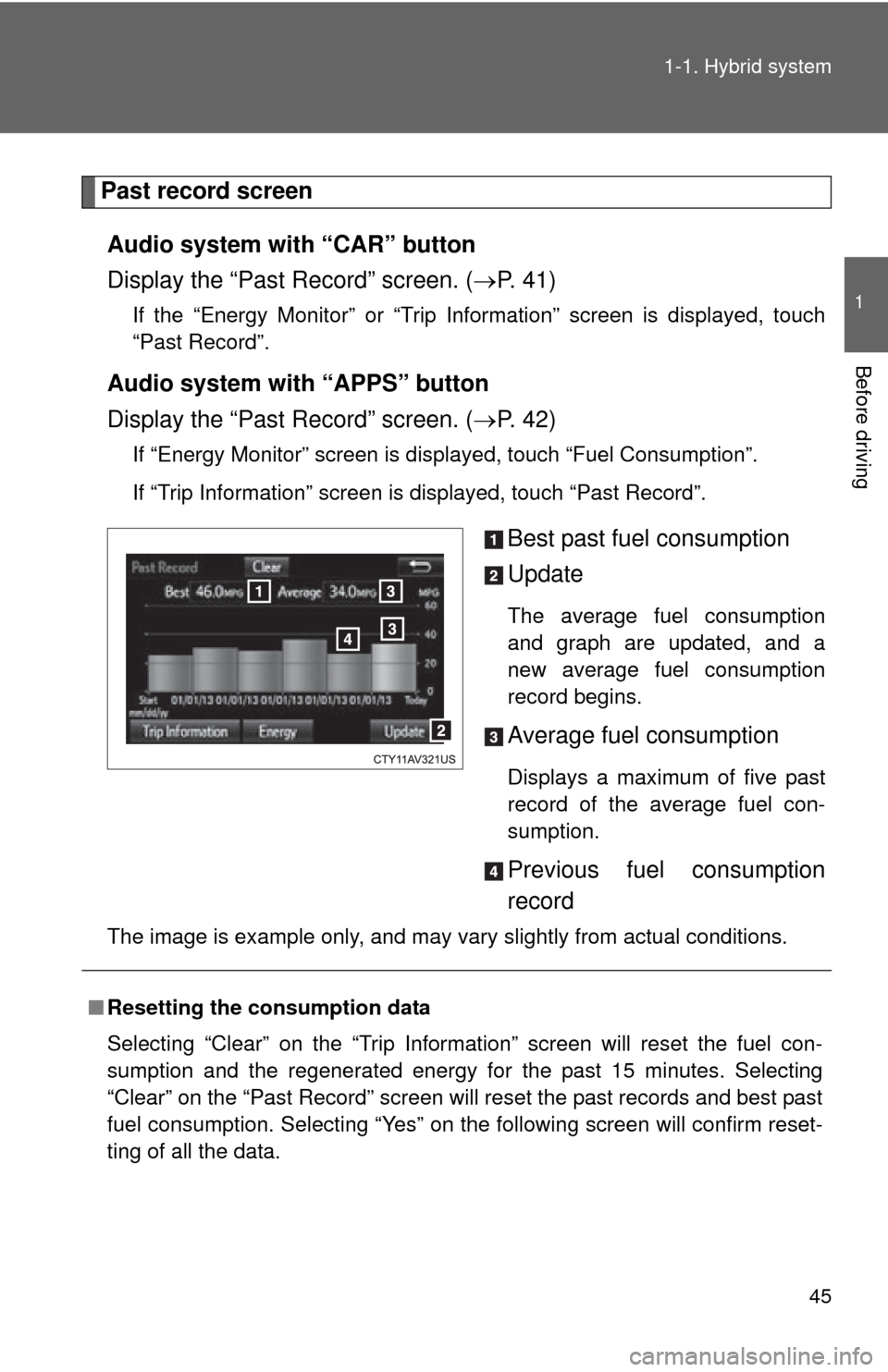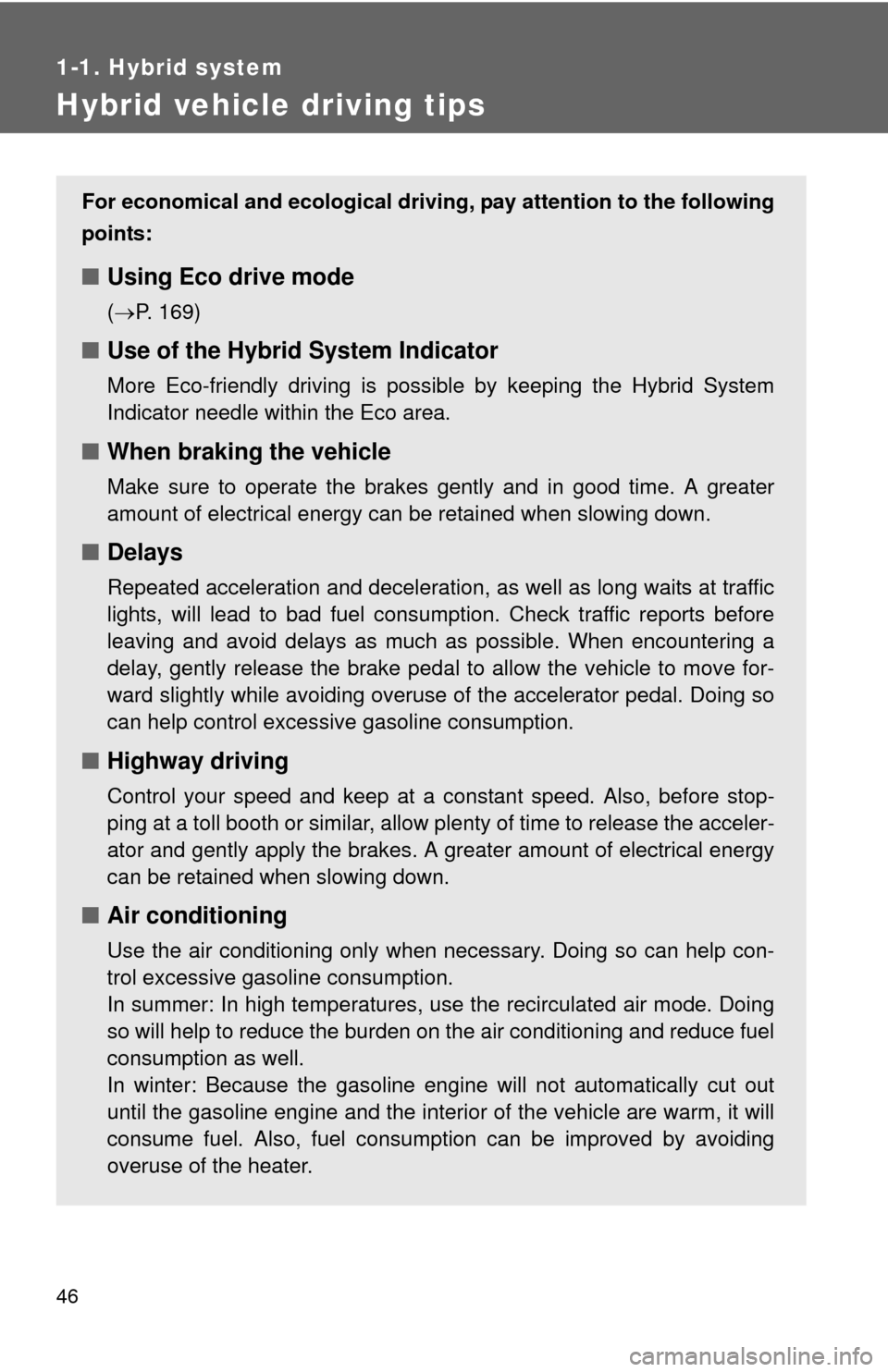Page 40 of 612
40 1-1. Hybrid system
NOTICE
■Hybrid battery air vent
●Do not place foreign objects over or in front of the air vent. The hybrid bat-
tery (traction battery) may overheat and be damaged.
● Clean the air vent regularly to prevent the hybrid battery (traction battery)
from overheating.
● Do not wet the air vent as this may cause a short circuit and damage the
hybrid battery (traction battery).
● Do not carry large amounts of water such as water cooler bottles in the
vehicle. If water spills onto the hybrid battery (traction battery), the battery
may be damaged.
Page 41 of 612
41
1
1-1. Hybrid system
Before driving
Energy monitor/consumption screen
Energy monitorAudio system with “CAR” button Press “CAR”.
If the “Trip Information” or “Past
Record” screen is displayed,
touch “Energy”.
You can view the status of your hybrid system on the multi-informa-
tion display and the audio system.
Audio system
Multi-information display
Page 42 of 612
42 1-1. Hybrid system
Audio system with “APPS” buttonPress “APPS”.
Select “Eco”.
If the “Trip Information” or “Past Record” screen is displayed, touch
“Energy”.
Multi-information display Push the “DISP” switch on the
steering wheel several times to
select the energy monitor dis-
play. (P. 185)
STEP1
STEP2
Audio systemMulti-information
display
When the vehi-
cle is powered
by the electric
motor (traction
motor)
Page 43 of 612
43
1-1. Hybrid system
1
Before driving
When the vehi-
cle is powered
by the gasoline
engine
When the vehi-
cle is powered
by both the gas-
oline engine and
the electric
motor (traction
motor)
When the vehi-
cle is charging
the hybrid bat-
tery (traction
battery)
When there is
no energy flow
Audio systemMulti-information
display
Page 44 of 612
44 1-1. Hybrid system
The image is example only, and may vary slightly from actual conditions.
Trip Information screenAudio system with “CAR” button
Display the “Trip Information” screen. ( P. 41)
If the “Energy Monitor” or “Past Record” screen is displayed, touch “Trip
Information”.
Audio system with “APPS” button
Display the “Trip Information” screen. ( P. 42)
If “Energy Monitor” screen is displayed, touch “Fuel Consumption”.
If “Past Record” screen is displayed, touch “Trip Information”.
Fuel consumption in the past
15 minutes
Displays the average vehicle
speed since the hybrid system
was started.
Displays the elapsed time
since the hybrid system was
started.
Cruising range
Regenerated energy in the
past 15 minutes
One symbol indicates 30 Wh.
Up to 5 symbols are shown.
The image is example only, and may vary slightly from actual conditions.Hybrid battery
(traction bat-
tery) status
LowFullLow
Full
Audio systemMulti-information
display
Page 45 of 612

45
1-1. Hybrid system
1
Before driving
Past record screen
Audio system with “CAR” button
Display the “Past Record” screen. ( P. 41)
If the “Energy Monitor” or “Trip Information” screen is displayed, touch
“Past Record”.
Audio system with “APPS” button
Display the “Past Record” screen. ( P. 42)
If “Energy Monitor” screen is displayed, touch “Fuel Consumption”.
If “Trip Information” screen is displayed, touch “Past Record”.
Best past fuel consumption
Update
The average fuel consumption
and graph are updated, and a
new average fuel consumption
record begins.
Average fuel consumption
Displays a maximum of five past
record of the average fuel con-
sumption.
Previous fuel consumption
record
The image is example only, and may vary slightly from actual conditions.
■Resetting the consumption data
Selecting “Clear” on the “Trip Information” screen will reset the fuel con-
sumption and the regenerated energy for the past 15 minutes. Selecting
“Clear” on the “Past Record” screen will reset the past records and best past
fuel consumption. Selecting “Yes” on the following screen will confirm reset-
ting of all the data.
Page 46 of 612

46
1-1. Hybrid system
Hybrid vehicle driving tips
For economical and ecological driving, pay attention to the following
points:
■ Using Eco drive mode
(P. 169)
■ Use of the Hybrid System Indicator
More Eco-friendly driving is possible by keeping the Hybrid System
Indicator needle within the Eco area.
■When braking the vehicle
Make sure to operate the brakes gently and in good time. A greater
amount of electrical energy can be retained when slowing down.
■Delays
Repeated acceleration and deceleration, as well as long waits at traffic
lights, will lead to bad fuel consumption. Check traffic reports before
leaving and avoid delays as much as possible. When encountering a
delay, gently release the brake pedal to allow the vehicle to move for-
ward slightly while avoiding overuse of the accelerator pedal. Doing so
can help control excessive gasoline consumption.
■Highway driving
Control your speed and keep at a constant speed. Also, before stop-
ping at a toll booth or similar, allow plenty of time to release the acceler-
ator and gently apply the brakes. A greater amount of electrical energy
can be retained when slowing down.
■Air conditioning
Use the air conditioning only when necessary. Doing so can help con-
trol excessive gasoline consumption.
In summer: In high temperatures, use the recirculated air mode. Doing
so will help to reduce the burden on the air conditioning and reduce fuel
consumption as well.
In winter: Because the gasoline engine will not automatically cut out
until the gasoline engine and the interior of the vehicle are warm, it will
consume fuel. Also, fuel consumption can be improved by avoiding
overuse of the heater.
Page 47 of 612
47
1-1. Hybrid system
1
Before driving
■
Checking tire inflation pressure
Make sure to check the tire inflation pressure frequently. Improper tire
inflation pressure can cause poor fuel consumption.
Also, as snow tires can cause large amounts of friction, their use on dry
roads can lead to poor fuel consumption. Use a tire that is appropriate
for the season.
■Luggage
Carrying heavy luggage can lead to poor fuel consumption. Avoid car-
rying unnecessary luggage. Installing a large roof rack can also cause
poor fuel consumption.
■Warming up before driving
Since the gasoline engine starts up and cuts out automatically when
cold, warming up the engine is unnecessary. Moreover, frequently driv-
ing short distances will cause the engine to repeatedly warm up, which
can lead to poor fuel consumption.